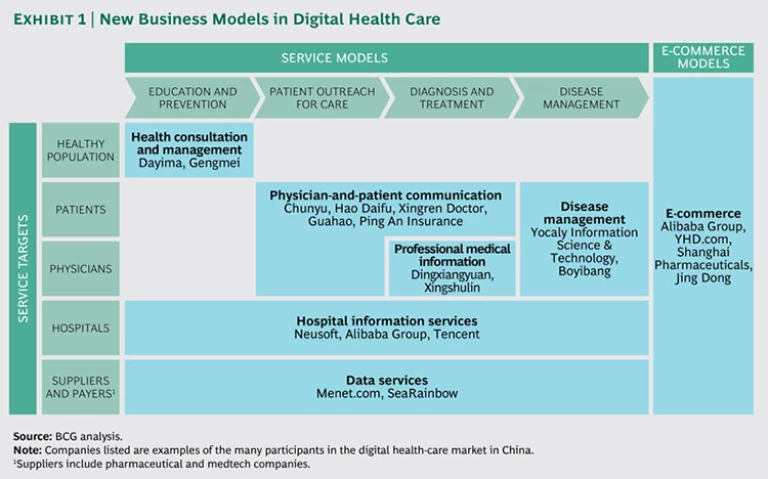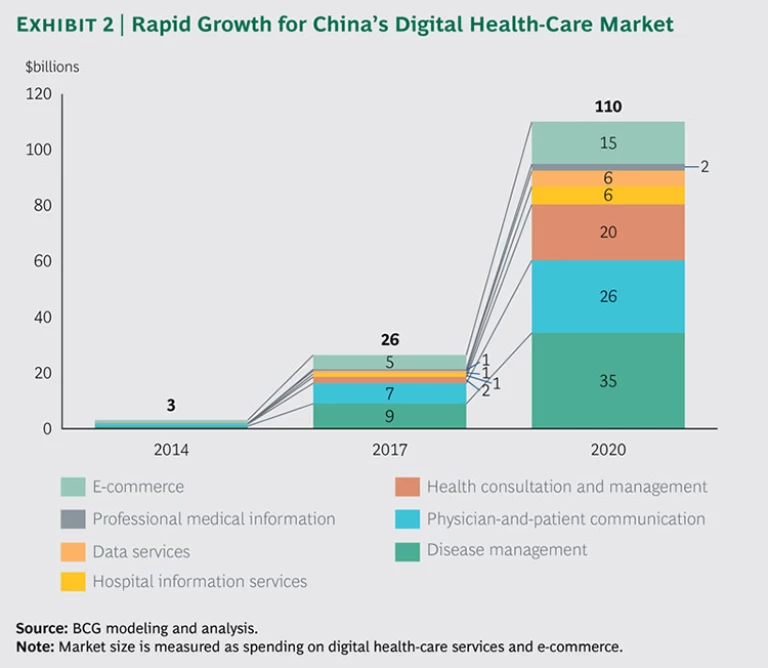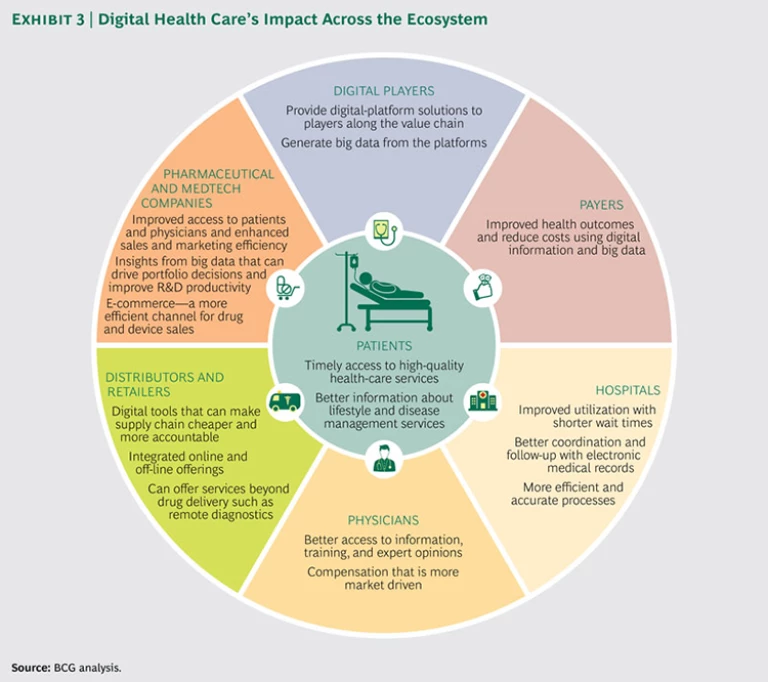In 2014, approximately $700 million in venture funding poured into digital health care in China, with investors supporting all things digital, from e-commerce to online physician-and-patient communication services to disease management apps. This is just the beginning.
As mobile and Internet-based technologies are developed and deployed to improve health care delivery for China’s population of 1.3 billion people, the nation’s digital health-care market will grow exponentially. We expect that this market (measured by spending on digital health care) will expand from $3 billion in 2014 to $110 billion in 2020.
Health care in China will be transformed. Every step will be affected: how patients are diagnosed, treated, and managed; how physicians and hospitals operate; how pharmaceuticals and medical-technology (medtech) devices are supplied and used; how payers structure their offerings.
The size and nature of the changes and opportunities will vary for stakeholders along the health care value chain, however. Some stakeholders will have the opportunity to digitize existing processes for improved efficiency. Some will encounter not opportunity but risk—they could find themselves cut out of the value chain altogether. But for others, technology advances will provide the opportunity to build entirely new businesses.
Regardless of the dynamics within any particular segment, all players must develop new mind-sets and new business models:
- Digital players newly entering the health care field must strike partnerships with hospitals, physicians, and other parties to capture first-mover advantages in e-commerce and certain services by leveraging their mobile payment, social- media, and search engine tools.
- Pharmaceutical and medtech companies need to harness digital tools to improve their sales and marketing efficiency, provide disease management solutions, and deploy big-data analytics to inform portfolio decisions and boost R&D productivity. They will need to enter into partnerships with e-commerce providers as consumers increasingly purchase products online. Those purchases, which currently include over-the-counter drugs, health food and supplements, and consumable medtech devices, are likely to encompass prescription drugs in the future.
- Drug distributors and retailers must move quickly to avoid being displaced. They must either build e-commerce capabilities of their own or partner with emerging e-commerce players.
- Payers have the opportunity to develop new businesses including digital services, such as remote physician consultation, that will help attract new customers in the near term. They can also use big-data analytics to lower costs and improve patient outcomes over the longer term.
Companies in all four categories have the opportunity to shape the digital transformation of the health care market in China.
Digital Health Care Takes Off
Three trends are driving the digital health-care revolution in China.
The first is the widespread adoption of new technologies such as mobile devices, cloud computing, and big-data analytics. In 2014, for example, almost 40 percent of people in China had a smartphone and used the device for three hours a day (on average). Combine that with the increasing availability of high-speed Internet access and big data, and companies will have the ability to offer digital solutions—everything from remote patient monitoring to drug purchasing using smartphones—to large swaths of the population in China.
The second is the continuing effort by the Chinese government to address long-standing inefficiencies and unmet needs within the health care system—an effort that digital health care will help to advance. Remote physician consultation and online appointment booking, for example, can help mitigate the overutilization of large hospitals—and the underutilization of smaller facilities—in China; many patients still flock to large facilities for basic needs like renewing a prescription. And new solutions that allow continual communication between physicians and patients will deliver much-needed improvements in patient care over the long term.
The third trend is an increasingly favorable regulatory environment. Following a $9.5 billion investment by the Ministry of Health (now the National Health and Family Planning Commission) in 2012 to develop electronic medical records (EMRs) and improve hospital information systems, the Chinese government has intensified its efforts to boost digital health care. For example, the government reduced barriers in e-commerce, making it easier to register online pharmacies, and is expected to allow certain prescription drugs to be sold online sometime in 2016. In addition, the government has allowed hospitals in some provinces to run pilots involving remote diagnosis and medication prescription.
The Landscape Today—and in the Future. As trends encouraging digital health care gather momentum, new business models are emerging, within both the health-care service and e-commerce spaces. (See Exhibit 1.) New digital entrants, including large, established companies as well as new venture players, are driving much of this effort as they stake out territory in health care and move to shape the digital health-care market.
For example, the search engine company Baidu is leveraging its core search business to offer health information to consumers and link consumers to online appointment booking and remote consultations. Baidu also now sells smart wearable devices through its Dulife brand. In partnership with the Beijing government, Baidu is using the devices to track and analyze health information; the aim is to improve health service delivery in the city.
Alibaba Group, meanwhile, has expanded its e-commerce platform to include online pharmacies and is developing an app that would leverage the company’s Alipay online-payment system to allow patients to fill prescriptions online. The company is also building a new service platform that will enable physicians to remotely diagnose and treat patients. And its “future hospital” initiative will allow hospitals to digitize their patient-services processes.
Social-media player Tencent is extending the reach of its Wechat social and payment platform into health care. The company rolled out Intelligent Health, an IT platform to provide hospitals with services such as online and mobile appointment booking and payments, in 2014. Tencent is also investing in companies to create a full suite of services for patients and physicians across the value chain. Among these investments is a stake in Dingxiangyuan, an online network for China’s health-care professionals.
At the same time, many venture-backed new players, among them Chunyu and Xingren Doctor, are developing offerings such as remote physician-consultation services. Traditional insurer Ping An Insurance, meanwhile, launched an app called Ping An Good Doctor, which, among other things, allows remote physician consultation. And some traditional pharmaceutical distributors and retailers, such as Shanghai Pharmaceuticals, are actively exploring e-commerce opportunities.
With increasing numbers of new entrants and investment, the momentum in digital health care is undeniable. Of the $110 billion in digital health-care spending that we project in China in 2020, health care services will account for the bulk of the market at $95 billion, and e-commerce will contribute approximately $15 billion.
A good portion of this growth will come from the redirection of existing spending in the off-line world to digital services. But the increase also reflects the development of entirely new businesses and revenue streams. Growth will be spread across digital health-care service segments, with the largest absolute increases in revenues concentrated in the already booming disease-management and physician-patient-communication segments. (See Exhibit 2.)
The Force of Digital Disruption Across the Value Chain. Plenty of obstacles to the development of digital health care in China will be encountered along the way. For one thing, regulatory uncertainty continues regarding remote diagnosis and treatment, online prescription sales, and patient reimbursement—and that uncertainty will naturally slow the uptake of these services. In addition, the use of disparate EMR systems across hospitals will make linking the databases among those facilities challenging. And given the overall lack of experience in large-scale health-care data management within China, some missteps and a steep learning curve are inevitable.
Despite such hurdles, the health care transformation will proceed, and it will produce rapid—and massive—change. In addition to the improved efficiency that digital tools can bring, IT and big-data analytics can create unprecedented transparency on real-world outcomes. This transparency, in turn, can lay the foundation for value-based health care in China, with the promise of increased efficiency, lower costs, and improved health outcomes.
The impact will be powerful for everyone in the health care ecosystem, starting with patients themselves and including all the players that have a role in their care. (See Exhibit 3.) New digital tools will allow patients to access high-quality health-care services anytime, anywhere. Patients will also find support to improve their lifestyle and to manage chronic diseases. Hospitals will be able to use digital technology to improve utilization rates, lower wait times, and reduce crowding. The adoption of EMRs will allow facilities to share records in real time, improving the efficiency of diagnosis and treatment. And physicians will have better access to professional information, training, and expert opinions while also being able to tap into new income streams for services such as online consultation.
Similarly, companies within the digital health-care ecosystem will need to adapt. New digital players, for example, will have the opportunity not only to transform the entire spectrum of existing health-care processes—from making appointments to filling prescriptions—but also to create entirely new businesses that are possible only because of digital technology. For pharmaceutical and medtech companies, the major opportunity will be in using digital tools to improve the efficiency and effectiveness of processes in a number of areas including how sales and marketing function and how decisions are made about the composition of the product portfolio. Distributors and retailers, meanwhile, face a major risk of disintermediation if they fail to tap into the e-commerce channel, which is more cost-efficient and convenient. And payers will have an opportunity not only to improve their existing business through data analytics but also to create valuable new services.
New Strategies for Players Across the Value Chain
Companies across the value chain must move now to capitalize on the opportunities—and confront the threats—that the digital health-care revolution presents. All health-care players should develop a comprehensive digital strategy based on the role they envision for their organization in the future, strike partnerships in order to gain a first-mover advantage, and move quickly to pilot new ideas. And for companies that traditionally have not played in health care or have yet to enter the space, the emergence of digital health care creates abundant opportunity. (See “Not Too Late.”)
NOT TOO LATE
Plenty of companies have not yet jumped into the digital health care space in China, among them investors, start-ups, and companies whose core business is not health care. Are they too late to the game?
Absolutely not. Given the potential size and nascent state of the digital health-care market in China, opportunities for companies that have yet to enter the fray abound.
Consider real estate. Real estate companies can partner with payers and providers to build communities that stand out for the health care services they offer. This could be quite attractive to senior citi-zens, who have a high demand for those services.
Other opportunities may exist in bringing together pharma and medtech companies, hospitals, and payers to build centers of excellence for treating certain diseases. This could involve creating facilities where patients could come to live while they receive cutting-edge treatment.
And still other opportunities could be found by using big data to dig into the etiology and pathophysiology of certain diseases, such as lung and gastrointestinal cancers, which are more prevalent in China than in many other parts of the world. Such analysis could prove valuable to pharma companies looking for new treatment targets.
Other markets that are further down the digital health-care path (such as the U.S., where investments in digital health care dwarf those in China to date) may offer interesting ideas. (See the exhibit below.) Studying the digital innovations in a market like the U.S. may help players in China identify promising approaches that could be adapted for the Chinese market. Such insights are likely to be one of many avenues that allow latecomers to catch up.
New Digital Players. For the big online and technology companies, the opportunity to provide valuable services across the health care value chain is vast. To capitalize on that opportunity, they need to offer end-to-end solutions, from the patient’s search for a good physician to appointment booking to remote management of patient care. Such end-to-end offerings have the best shot at attracting a large user base and building the strongest loyalty. A key step in developing those offerings: securing scarce resources such as partnerships with hospitals and physicians.
At the same time, these companies must design a business model that captures some of the profits now generated by others in the industry or creates new sources of profit. E-commerce companies, for example, can capture some of the margin that previously flowed to traditional distributors and retailers. And these new players can also provide big-data analytics on health outcomes—new services that will be extremely valuable to pharmaceutical companies and payers, among others.
Pharmaceutical and Medtech Companies. For pharma companies, the opportunity in digital health care is concentrated in four areas.
One is improving sales and marketing efficiency, an area where many companies are already running pilots. Here, companies can move beyond the traditional sales model, which focuses on face-to-face interactions with physicians, to use digital technologies to reach more physicians at the same or lower cost.
E-commerce is another area of opportunity. Online sales of over-the-counter drugs, health foods and supplements, and consumable medtech devices have been growing rapidly in recent years. And as the Chinese government begins to allow consumers to buy prescription drugs online, pharma companies need to follow. This will mean establishing partnerships with online pharmacies—whether new players or traditional distributors or retailers that have built e-commerce capabilities. This lower-cost channel will not only strengthen the connection that pharma companies have with consumers but also boost margins by eliminating layers in the supply chain. Pharma companies need to identify the winning e-commerce business platforms with which to link up, a decision that will depend in part on the specifics of their product portfolio.
In the burgeoning area of patient management, pharma players can develop new services in partnership with companies that provide mobile diagnostics, physician-and-patient communication services, and continuous patient-monitoring options. These offerings can improve patient outcomes, in part by ensuring that more people adhere to their prescription drug regimens.
The fourth area is a longer-term—but major—opportunity: generating new insights based on big data. Data on patient treatment and outcomes, for example, can help determine the value of individual prescription drugs. That information, in turn, can provide the basis for making decisions on pricing and on acquisitions and divestments within the product portfolio. And big data will be a powerful tool for improving R&D productivity. Analyzing outcomes data, for example, can point the way toward new uses for a compound or help identify patients most likely to respond to a certain treatment.
Medtech companies have opportunities in the same four areas as pharma players. In addition, medtech companies can use new approaches to better support medical personnel and patients using their devices. Software embedded in an ultrasound device, for example, could provide more guidance on using the machine and interpreting results. At the same time, 3-D printing has the potential to allow local customization and production of devices such as hip implants. And medtech companies are looking for ways to tap all the data they already generate across devices. Pulling all that information together and mining it for insights on how to improve health outcomes will be extremely valuable to both medtech companies and payers.
Distributors and Retailers. The digital health-care revolution offers considerable upside for pharma and medtech companies, but the story is quite different for distributors and retailers, especially small ones. Digital health care—and e-commerce in particular—could make these players less relevant.
Certainly, the shifting dynamics in health care in China create some opportunity for distributors and retailers. For example, as prescriptions are increasingly filled in retail pharmacies—rather than in hospital pharmacies, which is the norm in China currently—retailers and distributors will have an opening to capture some of that business. At the same time, however, they face a major risk of being displaced by e-commerce competitors.
To succeed, distributors and retailers will need to offer competitive pricing. They must create seamless integration between their online and brick-and-mortar operations and enhance the customer experience for patients and small retailers.
With those requirements in mind, the right strategy depends in large part on the starting position of the distributor or retailer.
Large, national players can leverage the strength of their nationwide network and logistics infrastructure to build their own e-commerce platform. To do so, they must quickly strike partnerships with hospitals and providers to ensure access to patients who need to fill prescriptions.
Regional distributors and strong retailers, meanwhile, will need to establish a larger geographic footprint through mergers, acquisitions, and partnerships. Without that reach, they risk drawing weak online traffic and being underpriced by bigger competitors with major scale advantages.
Finally, smaller players that do not wish to or are unable to tap into broad e-commerce platforms can explore niche plays in areas such as specialty drugs, exit the business altogether, or consider the possibility of being acquired.
Those distributors and retailers that do manage to make the transition to e-commerce have new business opportunities as well. They can offer value-added services such as data analytics to pharmaceutical companies based on disease treatment patterns, for example. Such services will help preserve their overall margins and solidify their position against competitors.
Already, some leading distributors and retailers are moving aggressively. Shanghai Pharmaceuticals, a leading distributor and retailer, is partnering with online retailer Jing Dong to build an e-commerce platform that will allow it to sell pharmaceuticals to consumers as well as to other pharmacies. The company is building on its traditional strength—partnerships with hospitals—to ensure that its e-commerce operation has access to the flow of patient prescriptions. Meanwhile, partnering with Jing Dong will draw large online traffic and provide delivery directly to patients’ homes. Jing Dong's last-mile delivery capability complements Shanghai Pharmaceuticals’ national logistics infrastructure. The company is also exploring how the drug usage information it generates can be harnessed to offer marketing insights for pharma companies.
Payers. For payers, digital health care creates an opening to move beyond being simply the bearer of costs to become an effective manager of health care benefits.
Digital tools can be used to develop online diagnosis and treatment options, offerings that will help to increase the customer base in the near term. Insurer Ping An, for example, has hired approximately 300 general practitioners to offer digital diagnosis and treatment services to the company’s insured population. Over the medium term, payers can use big-data tools to evaluate claims data; those analyses can lead to better pricing and targeted product offerings.
Over the longer term, payers can use big-data analysis of outcomes to identify which drugs and medical procedures are most effective for specific conditions. This will allow them to create attractive patient-management programs for customers, especially large employers.
Winning in the Digital Health-Care Age
The trajectory in China is clear. Digital health care is ramping up rapidly and will transform the business of all players across the value chain. It is critical for companies to understand how they are likely to be affected—and to develop strategies that reflect that insight.
For some, adapting to the digital health-care wave will in large part involve digitizing existing processes to improve efficiency. This will be a major effort for pharmaceutical and medtech companies as they adopt digital tools in areas such as sales and marketing and portfolio optimization.
Distributors and retailers must confront the fact that the primary impact on them is likely to be disintermediation. As a result, they must move quickly to develop business models that keep them in the game.
Finally, there is the opportunity to build entirely new businesses. This potential exists in many steps along the value chain, including big-data services that can be built by digital companies and patient benefit management services that can be offered by payers. All players need to identify where new technology will allow them to offer novel products or services.
Regardless of whether the changes in health care are a major threat or a tantalizing new opportunity, companies must respond now. In the digital age, inaction will lead to failure.












